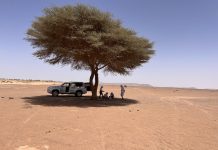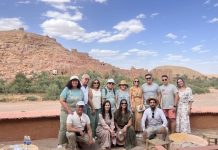Rolling trail in Sedona. Photo: Matt Miller
There’s an old saying when it comes to visiting the great outdoors — take only pictures, leave only footprints. Or, in the case of mountain bikers, leave only tire tracks….in the right places.
The sport of mountain biking has changed a lot over the years. Gone are the days of V-brakes, fixed seat posts, skinny tires, and steep head tube angles. Modern bikes are built for speed and stability, and suspension is better than ever. Innovations have led to far more people buying bikes and enjoying the sport. Coupled with social media, more people are on the trails than ever before.
With that growth comes challenges. Increased demand on trailhead parking, crowd management, and on educating new riders regarding proper trail etiquette. Because of their natural beauty and enjoyable, exciting trails, several areas have seen a huge increase in visitation and trail users.
Sedona in flight
Trail workers and fresh cut trails in Sedona. File photos: Kevin Adams
Sedona, Arizona is surrounded by beautiful red rock formations, scenic forests, and lots of singletrack. And the secret is out. A town of 10,000 now hosts three million visitors per year, and the infrastructure of Sedona and the surrounding area is struggling to keep pace.
“It used to be the busy holiday weekends you would get some extra traffic,” said Marty Glinsky, President of the Board of Directors for the Verde Valley Cyclist Coalition (VVCC). “Then it was Christmas week as well. Then spring break. 15% or so are mountain bikers. Having the mountain bike festival increased how [well] known Sedona and the Verde Valley is for mountain bikers.”
Glinsky notes that many of Sedona’s first trails were illegally built by mountain bikers without the approval of the U.S. Forest Service (USFS). Before the VVCC started working with the agency to improve the trails, there was mistrust between riders and land managers. One of the priorities of the VVCC is maintaining good relations between the USFS, other trail users, local residents, and mountain bikers.
“We work very closely with the USFS, and provide considerable funding,” said Glinsky. “We have a budget of $180,000 this year, and $150,000 will go directly to trail maintenance and new trail construction in the Coconino and Prescott Forests. We want to help reduce congestion on the more popular trails and spread out trail users. There are some very well known trails in and around Sedona. In order to reduce potential trail conflict, we want to create new trails where appropriate.”
In addition to maintenance and new trail construction, VVCC has put in place the Red Rock Mountain Bike Patrol. With over 60 volunteer patrollers, the goal is to interact with users, and it has been a positive development. The USFS says negative interactions between mountain bikers and other trail users have been reduced dramatically.
Sustainability is a top concern at the Sedona Chamber of Commerce. A few years ago, Glinsky approached the Chamber about supporting the trails.
“I said ‘you advertise, you have T-shirts in T-shirt shops. You rely on visitors for your income.’ So I approached the Chamber about funding to give back to the trails. They did it. The USFS receives more than $50,000 yearly from the Chamber, and considerably more from the Sedona Red Rock Trail Fund (SRRTF). The VVCC was instrumental in bringing attention to the importance of the trail system to the economics of our region.”
How can mountain bikers lower our impact when we visit Sedona and other towns? Glinsky offered a few tips:
- Pick up after your dogs. It’s something they mention on patrol (sadly, some people respond by saying “do you pick up after coyotes?”)
- Graffiti is a major challenge. Carving into rock is still graffiti and patrollers will report it to The Friends of the Forest, another volunteer group that developed a unique slurry to remove graffiti from the red rocks.
- Don’t bike off trail as it can damage sensitive ecological and archaeological areas.
- Don’t bike in inclement weather. Give the trails time to dry.
- Yield to horses and hikers and ride under control. Even if you think you’re in control at 15MPH, the equestrians and hikers don’t know that.
The VVCC is proactive about managing the increased visitation and subsequent pressure on the trails. They work with the USFS several times per year and highlight priority trails for maintenance. Then the USFS highlights the trails they believe need maintenance, and the two move forward. Glinsky says the collaboration with SRRTF, the VVCC, and the Chamber is vital to raise money for maintenance projects.
“We sit down with the USFS several times per year,” said Glinsky. “In the planning meeting we bring our list of trails that need work, and new trails we’d like to see developed. The USFS brings their list. Together, we develop a plan for moving forward, and discuss the funds necessary to achieve our collective goals. Then we discuss the budget needed to initiate the plan. The VVCC and the SRRTF commit to raising the money. The Forest Service would find it very difficult to raise these funds if it weren’t for the VVCC, the SRRTF, and the Chamber of Commerce.”
Gratitude for trail access

Another area feeling the effect of increased tourism and the growth of mountain biking is the Kingdom Trails in rural Vermont. Located near the tiny towns of Burke, Lyndonville, Kirby, and East Haven, the trail network grew rapidly, leading to conflict between riders and landowners, and ultimately severed access to many beloved trails.
“From 2013-2019 there was a 132% increase in visitors,” said Abby Long, Executive Director of the Kingdom Trail Association (KTA). “Now, due to Covid our visitor numbers have drastically decreased with the Canadian border having been closed. We see less than 100,000 visits per year.”
Pre-pandemic, Long notes that the Kingdom Trails had an estimated 135,000 visits per year. With a high percentage of visitors typically coming from Canada, that number has dropped significantly with border closures. In 2021, Long estimates they had about 75,000 visits, many of which are probably the same people visiting multiple times.
The Kingdom Trails network is unique in that it is located on private land. Encouraging users to recreate in a way that maintains a good relationship with the land owners is a priority for KTA. “The trail network flows through four very small towns,” said Long. “The large number of visitors puts pressure on the rural village infrastructure, as well as causing stress for the land owners.”
KTA recently participated in a USDA funded capacity study, which showed the trails are not at capacity, but supporting amenities are. Lack of sufficient parking remains a challenge, which has led to illegal parking and congestion issues. They also have safety concerns when it comes to pedestrian crossings in small villages.
“We have improved our educational messaging, and as part of that have partnered with a mountain bike collaborative called Bike Borderlands (a regional group), that works to stimulate sustainable community development in the rural Northeast, and has created a code of conduct called Ride with Gratitude. It’s a helpful message to share with people that it’s not a right to be on the trails, it’s a privilege. We want Ride with Gratitude to extend beyond the trails, to interaction in the small communities and local businesses.”
Long offered a few tips for mitigating our impact as mountain bike tourists in areas where trails may flow through private land.
- Park in appropriate places.
- Ride single file on roads when connecting trails.
- Go to the bathroom in designated areas.
- Plan ahead, and practice Leave no Trace.
- Be polite to trail users, land owners, community members, and business owners. They recently changed their yield policy – everyone yields to everyone.
KTA is addressing the rise in visitation numbers, and maintaining good relations between trail users and local landowners. With numerous recommendations from the USDA study, the KTA is working on a master plan that includes a welcome center along with municipal parking, and they are planning to build connector trails to get more bikes off of roads, as well as incorporating more trail ambassador staff who can talk with and educate visitors. KTA is also holding a community chat series with landowners.
Keeping singletrack single on the Western Slope

Similar to Sedona and rural Vermont, the Western Slope of Colorado is a remote area that has seen a huge increase in visitation.
Established in 1989, the Colorado Plateau Mountain Bike Association (COPMOBA) has four chapters, and was born out of an idea to create a trail that traversed the entire Colorado Plateau – from Aspen, through Grand Junction, and on to Flagstaff. What ended up being built was the Kokopelli trail from Grand Junction to Moab. Since that time COPMOBA has continued trail developments within the Grand Valley area.
John Howe volunteered for COPMOBA for many years, then held a Board position for several years, and recently became President. Howe has lived in Grand Junction for over 30 years, and used to see a handful of cars at the Lunch Loop trailhead in the early 1990s. He now sees up to 150 cars on a busy day.
“We’ve seen an increase in visitors, particularly during the peak season of spring and fall,” said Howe “We’ve also seen a large increase in local users as well. The whole vibe in Grand Junction has changed over the years, with a lot more people moving here due to the access to outdoor recreation.”
As with other places that are seeing an increase in visitation, there are impacts that go along with it. More erosion. More encounters on the trail. Increased trail width.
“Some people ride three or four feet off the trail,” said Howe “A good example is the 18 Road trail network. There are some technical moves. People end up stopping, and getting stacked up a little bit. That has caused trail widening.”
Howe offered some tips for sustainable riding and travel, considering what he’s seen in Western Colorado.
- Keep singletrack single.
- Observe common trail etiquette – yield right of way to uphill riders and pedestrians. The vast majority of hikers and runners will get out of your way, just be respectful. When you do yield, just go to the edge of the trail, and put a foot down.
- Do some basic research about the trail system. Know what type of terrain you’re getting into.
- Don’t ride muddy trails. That has been a huge problem recently. Given the soil composition on the Western Slope, once the trails are muddy, it’s a no go for riding due to the bentonite and shale.
As with other Mountain Bike Associations, COPMOBA works diligently to manage the increased use.
“The Montrose chapter just got a big grant from Colorado Parks & Wildlife to construct the Electric Hills project,” said Howe. “In the near future we are collaborating with the City of Fruita, the Bureau of Land Management, Mesa County, and local businesses regarding developing 32+ miles of new trails in the 18 Road/North Fruita Desert area. We are in the initial planning stages for expansion of the Kokopelli Loops area – infill, putting in new trails, reroutes of existing trails. We also want a comprehensive plan for the trails in Kokopelli loop area.”
Leave it better than before

The next time you visit a place like Sedona, Kingdom Trails, Grand Junction, or one of the other popular mountain biking locations around the country, keep in mind we all need to be cognizant of proper etiquette, both on and off the trail. Associations like VVCC, Kingdom Trails, COPMOBA, and others work in their local communities because they want everyone to enjoy the wonderful trail systems nearby – whether it’s long-time local residents, or cyclists visiting for the first time.












